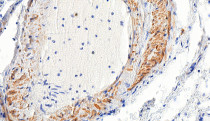ARG63621
anti-alpha smooth muscle Actin antibody
anti-alpha smooth muscle Actin antibody for ICC/IF,IHC-Formalin-fixed paraffin-embedded sections,IHC-Frozen sections,Western blot and Human,Mouse
Cell Biology and Cellular Response antibody; Controls and Markers antibody; Signaling Transduction antibody; Cancer-associated fibroblast antibody; Smooth Muscle Marker antibody; CAF Marker antibody; Mural cell Marker antibody; Myofibroblast Marker antibody; Angiogenesis Study antibody; Microvascular Density Study antibody

Overview
| Product Description | Goat Polyclonal antibody recognizes alpha smooth muscle Actin |
|---|---|
| Tested Reactivity | Hu, Ms |
| Predict Reactivity | Dog, Rat |
| Tested Application | ICC/IF, IHC-Fr, IHC-P, WB |
| Specificity | Variants NP_001604.1 and NP_001135417.1 encode the same protein. |
| Host | Goat |
| Clonality | Polyclonal |
| Isotype | IgG |
| Target Name | alpha smooth muscle Actin |
| Antigen Species | Human |
| Immunogen | EEEDSTALVC |
| Conjugation | Un-conjugated |
| Alternate Names | Cell growth-inhibiting gene 46 protein; MYMY5; ACTSA; Alpha-actin-2; Actin, aortic smooth muscle; AAT6 |
Application Instructions
| Application Suggestion |
|
||||||||||
|---|---|---|---|---|---|---|---|---|---|---|---|
| Application Note | WB: Recommend incubate at RT for 1h. IHC-P: Antigen Retrieval: Heat mediation was performed in Citrate buffer (pH 6.0). * The dilutions indicate recommended starting dilutions and the optimal dilutions or concentrations should be determined by the scientist. |
Properties
| Form | Liquid |
|---|---|
| Purification | Purified from goat serum by antigen affinity chromatography. |
| Buffer | Tris saline (pH 7.3), 0.02% Sodium azide and 0.5% BSA. |
| Preservative | 0.02% Sodium azide |
| Stabilizer | 0.5% BSA |
| Concentration | 0.5 mg/ml |
| Storage Instruction | For continuous use, store undiluted antibody at 2-8°C for up to a week. For long-term storage, aliquot and store at -20°C or below. Storage in frost free freezers is not recommended. Avoid repeated freeze/thaw cycles. Suggest spin the vial prior to opening. The antibody solution should be gently mixed before use. |
| Note | For laboratory research only, not for drug, diagnostic or other use. |
Bioinformation
| Database Links | |
|---|---|
| Background | The protein encoded by this gene belongs to the actin family of proteins, which are highly conserved proteins that play a role in cell motility, structure and integrity. Alpha, beta and gamma actin isoforms have been identified, with alpha actins being a major constituent of the contractile apparatus, while beta and gamma actins are involved in the regulation of cell motility. This actin is an alpha actin that is found in skeletal muscle. Defects in this gene cause aortic aneurysm familial thoracic type 6. Multiple alternatively spliced variants, encoding the same protein, have been identified. [provided by RefSeq, Nov 2008] |
| Highlight | Related Antibody Duos and Panels: ARG30051 Smooth Muscle Marker Antibody Duo (Desmin, SMA) ARG30328 Angiogenesis Antibody Panel Related products: alpha smooth muscle Actin antibodies; alpha smooth muscle Actin Duos / Panels; Anti-Goat IgG secondary antibodies; Related news: New antibody panels for Myofibroblasts and CAFs Besides tumor suppression, what’s p53 busy for during embryogenesis? New antibody panels and duos for Tumor immune microenvironment Anti-SerpinB9 therapy, a new strategy for cancer therapy |
| Research Area | Cell Biology and Cellular Response antibody; Controls and Markers antibody; Signaling Transduction antibody; Cancer-associated fibroblast antibody; Smooth Muscle Marker antibody; CAF Marker antibody; Mural cell Marker antibody; Myofibroblast Marker antibody; Angiogenesis Study antibody; Microvascular Density Study antibody |
| Calculated MW | 42 kDa |
| PTM | Oxidation of Met-46 and Met-49 by MICALs (MICAL1, MICAL2 or MICAL3) to form methionine sulfoxide promotes actin filament depolymerization. MICAL1 and MICAL2 produce the (R)-S-oxide form. The (R)-S-oxide form is reverted by MSRB1 and MSRB2, which promote actin repolymerization (By similarity). Monomethylation at Lys-86 (K84me1) regulates actin-myosin interaction and actomyosin-dependent processes. Demethylation by ALKBH4 is required for maintaining actomyosin dynamics supporting normal cleavage furrow ingression during cytokinesis and cell migration. (Microbial infection) Monomeric actin is cross-linked by V.cholerae toxins RtxA and VgrG1 in case of infection: bacterial toxins mediate the cross-link between Lys-52 of one monomer and Glu-272 of another actin monomer, resulting in formation of highly toxic actin oligomers that cause cell rounding (PubMed:19015515). The toxin can be highly efficient at very low concentrations by acting on formin homology family proteins: toxic actin oligomers bind with high affinity to formins and adversely affect both nucleation and elongation abilities of formins, causing their potent inhibition in both profilin-dependent and independent manners (PubMed:26228148). |
Images (3) Click the Picture to Zoom In
-
ARG63621 anti-alpha smooth muscle Actin antibody WB image
Western blot: 30 µg of MEF cell lysate stained with ARG63621 anti-alpha smooth muscle Actin antibody at 1:300 dilution.
-
ARG63621 anti-alpha smooth muscle Actin antibody ICC/IF image
Immunofluorescence: Paraformaldehyde fixed HepG2 cells permeabilized with 0.15% Triton. Cells were stained with ARG63621 anti-alpha smooth muscle Actin antibody (green) at 10 µg/ml dilution for 1 hour. DAPI (blue) for nuclear staining. Negative control: Unimmunized goat IgG (green) at 10 µg/ml dilution.
-
ARG63621 anti-alpha smooth muscle Actin antibody IHC-P image
Immunohistochemistry: Paraffin-embedded Human lung tissue. Antigen Retrieval: Heat mediation was performed in Citrate buffer (pH 6.0). The tissue section was stained with ARG63621 anti-alpha smooth muscle Actin antibody at 3.5 µg/ml dilution followed by HRP-staining.
Customer's Feedback












